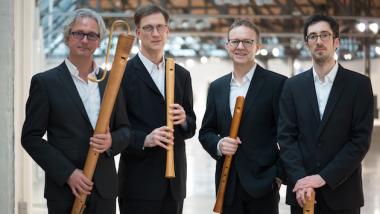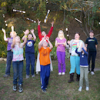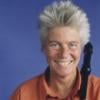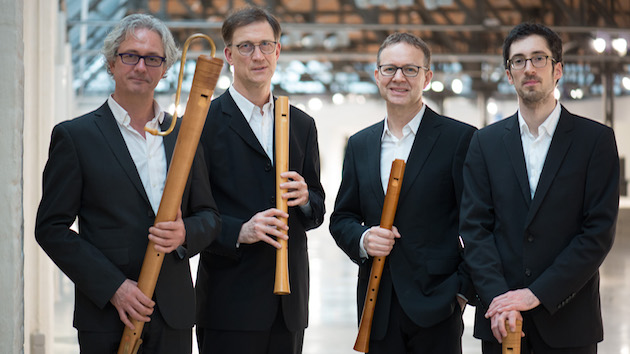
The Flanders Recorder Quartet faces a challenge. Their ensemble is quieter in tone and sonic profile than a string quartet, and, while it was popular in the Renaissance, there isn’t much music written for it. At a San José Chamber Music Society concert at the Trianon Theatre on Sunday, February 25, this quartet from Belgium showed what it could do to transcend those limits.
Its repertory consists of arrangements and commissions. Much of the former came from the Renaissance and Baroque. Viol consort suites by Matthew Locke (Henry Purcell’s mentor) and Johann Hermann Schein, played calmly without drama even in the fastest movements, brushed dignified shoulders against a solemn fantasia and fugue pairing from J.S. Bach. As performer Paul Van Loey pointed out at the preconcert talk, the recorder produces sound in the same manner as an organ pipe. The precision of the playing was fine enough that, with closed eyes, the Bach could have passed for music coming from some thin, breathy portative organ.
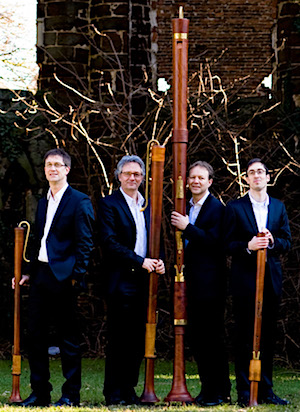
The organ-like quality of the sound was emphasized by the low-pitched instruments, a choice also made for a melancholy piece by one of the few modern composers equally amenable to unconventional arrangements, Astor Piazzolla. The players had an array of large and small wooden recorders spread on the stage around them, and the first of their secrets for putting sonic interest in the program was selecting variously from this battery.
Fine though all the arrangements were, the highlight of the concert came with the commissioned works, all recently written. Performer Bart Spanhove said that the Quartet encourages composers by telling them that recorders can play anything other instruments can, so that commissions don’t become an endless series of variations on Frère Jacques.
Sören Sieg is a German composer whose suite Inxaxheba is inspired by Xhosa music, carrying characteristic rhythms and melodies. An elegy for the composer’s father featured a mournful tune by Van Loey over deep lowering from the other three. The finale reversed this, with three higher-pitched instruments chiming together over bass patterns from Tom Beets. The whole was beautiful and effective.
A pair of pieces by a Belgian composer, Pieter Campo, were equally beautiful and even more illuminating sonically. In Fire, crisp, dissonant, shared lines and a slightly sour harmony were reminiscent of some of Carl Orff’s Schulwerk. The clarity and lightly floating quality of a recorder consort — applicable even to the six-foot tall contrabass, which made several appearances in the program — made compositional differences in harmonic style stand out strongly. Contrasts like Campo’s sour against Piazzolla’s sweet made for another assurance of variety in the program.
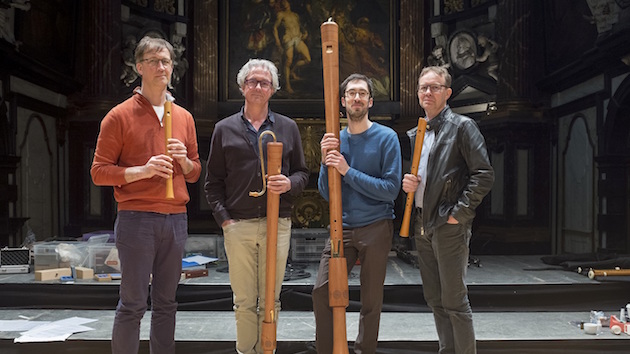
In Campo’s Meditation, Beets, playing high-pitched lead over oscillating accompaniment, produced an effective vibrato by shaking his instrument around as he played. He didn’t try for this effect elsewhere, but special sonic effects in general were one more source of variety. The Quartet’s favorite effect is to blow air pitchlessly through the instruments. This first appeared as little wisps of raw air in the Saraband of Locke’s Suite in F. There was more breathiness in Sieg’s opening movement. The sonic effects really took over during the popular music that concluded the program and formed the encores. Joris Van Goethem played a comically tooting bass for Louis Prima’s swing-era song “Sing, Sing, Sing,” and one encore produced the sound of a circus calliope organ, including having it run out of steam, courtesy of awesomely precise timing by the players. The other encore, which seemed to incorporate allusions to the Peruvian song “El Cóndor Pasa” by Daniel Alomía Robles (known up north in the Simon and Garfunkel version), enabled the players to reproduce a jungle’s worth of tropical birds.
After 30 years in practice (two of the original members are still with the group), the Quartet is slowly winding its career to a close. This was its third concert for the Society and will be its last. The players are on an extended world tour and plan to conclude in December back in Belgium. Their ensemble will be missed.

